The 5 Best Pelvic Floor Exercises From a Pelvic Floor Physical Therapist
Taking care of your pelvic floor is so important—start here with these yoga-inspired exercises and stretches.
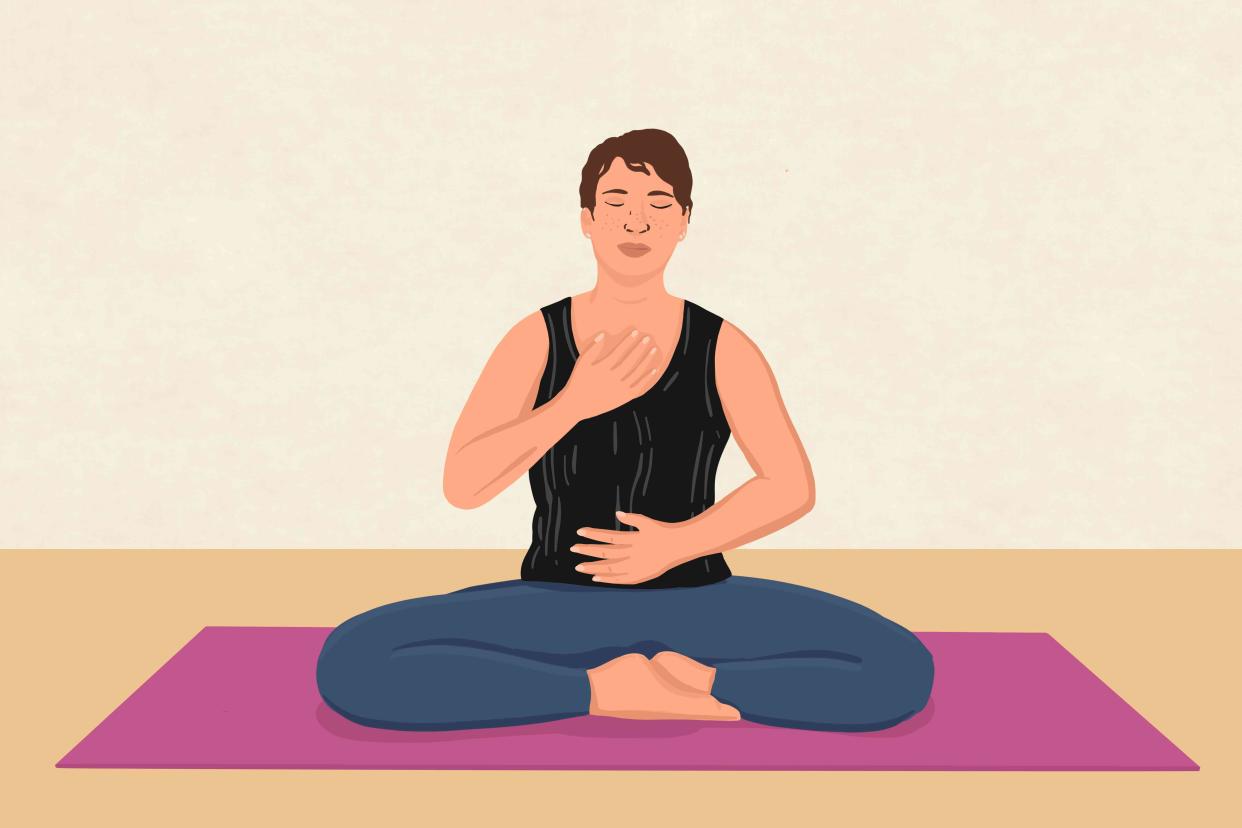
Grace Canaan
When was the last time you thought about doing exercises to strengthen your pelvic floor? Probably never, right? It turns out that strengthening this particular group of key muscles may be just as important as strengthening the muscles in your legs, arms, back, and chest.
And it’s also important to know that the pelvic floor isn’t something that only pregnant women need to worry about. “Everybody can benefit from awareness of where the pelvic floor is, how to relax it, and how to engage it,” says Natalie Trubin, PT, DPT, pelvic floor and orthopedic physical therapist in Hoboken, N.J., and a prenatal yoga instructor with YogaRenew Teacher Training.
What Is the Pelvic Floor?
The pelvic floor generally refers to a complex group of muscles and tissues that sit along the bottom of the pelvis creating a hammock-like structure between the pubic bone and tailbone. “The pelvic floor is involved in bladder, bowel, and sexual function, as well as stability of the pelvis and surrounding areas of the body,” Trubin says. This includes spine and hip stability.
When you have a dysfunctional pelvic floor or weakness in the area, however, problems can arise. For starters, you might have stress urinary incontinence, where you leak while doing physical exertion, Trubin says. Constipation, pelvic pain, and pelvic organ prolapse are other issues that can arise.
Related: 7 Facts About Pelvic Floor Health That (Almost) Everyone Gets Wrong
The Importance of Pelvic Floor Awareness, Strength, and Control
When it comes to exercising your pelvic floor, you need to find a balance between its length and strength. “Most online recommendations for pelvic floor exercises simply recommend strengthening, which is great if you have weakness,” Trubin says. “However, many people have a tight pelvic floor or one that’s in a state of resting tension—these people would benefit from lengthening the pelvic floor.”
Pelvic Floor Tightness vs. Weakness
Signs of a tight pelvic floor can include constipation, pelvic pain, pain with penetration (even when inserting a tampon), incomplete emptying when you urinate, and urinary incontinence or leaking.
Meanwhile, pelvic floor weakness, which can affect anybody, is common after pregnancy and childbirth, even if you have a cesarean section. Signs of pelvic floor weakness include heaviness in the pelvic floor; leaking urine with coughing, sneezing, or lifting; and feeling “vulnerable” when you do deep breathing or squatting exercises.
If you suspect your pelvic floor is either tight or weak, exercises designed for the pelvic floor can be helpful in restoring function and easting symptoms. And it doesn’t take long. Just a few weeks should do the trick, Trubin says. If not, talk to your health care provider.
Below are five yoga-inspired exercises that target the pelvic floor, helping you gain a mind-body connection and awareness with this important muscle group. “Yoga involves poses that stretch and strengthen the pelvic floor,” Trubin says. Yoga also links breath through movement, and breath is one of the best ways to connect with your pelvic floor.
Easy Pelvic Floor Exercises
Do these five basic pelvic floor exercises, poses, and stretches several times a week for best results.
Happy Baby (Ananda Balasana)
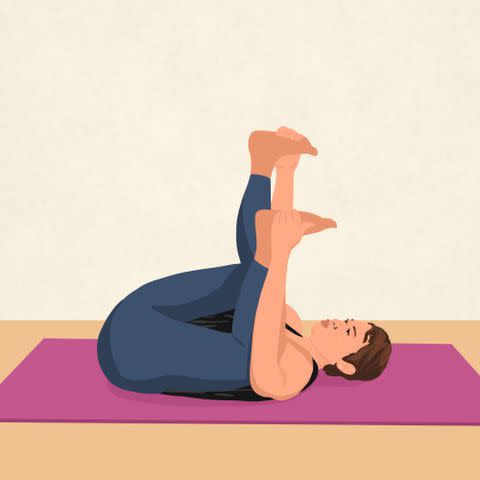
Grace Canaan
Lie face up on the floor. Bring your knees toward your chest so your legs form 90-degree angles in the air. Position your feet so the soles are facing toward the ceiling. Keeping your head on the floor, grab the outsides of both your feet and hold for two to three minutes, breathing deeply (but gently).
Pelvic floor benefits: Happy baby pose elongates the pelvic floor muscles and stretches the surrounding muscles of the hips and pelvis that can contribute to pelvic floor tightness.
Static Squat (Malasana)
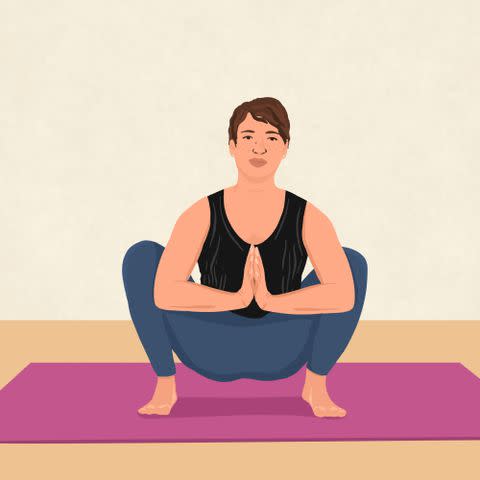
Grace Canaan
Stand with your feet slightly wider than hip-width apart and toes turned slightly outward. Lower your hips down as far as you comfortably can. With your elbows inside your knees, press your palms together and use your elbows to press your knees apart. Lengthen your spine and hold here.
To help focus more on lengthening and relaxing your pelvic floor, place a block or two under your sitz bones and think about relaxing the pelvic floor as you inhale. If you’re using blocks, hold one to two minutes. Without blocks, do several rounds, holding for 10 to 20 seconds each.
Pelvic floor benefits: Static squats strengthen and lengthen the pelvic floor, thanks to the deep flexion and opening of the hips.
Related: 5 Hip Mobility Exercises for Stronger, Pain-Free Hips
Chair Pose (Utkatasana)
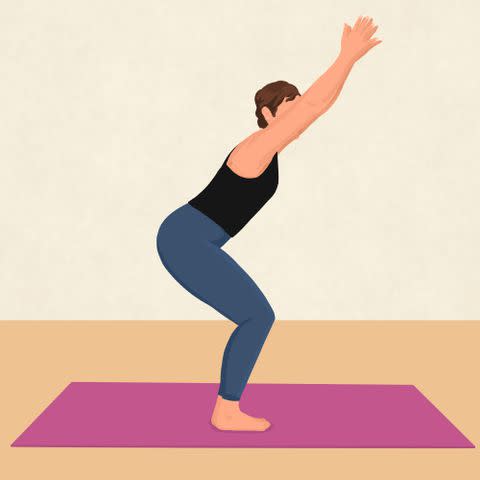
Grace Canaan
Stand with your feet hip-width apart. Keeping your weight in your heels, lower your hips so your thighs form roughly 45-degree angles with the floor. Watch that your knees aren’t going past your toes. From this position, extend your arms until your elbows are parallel with your ears (or straight out at shoulder height if overhead is difficult). If your pelvic floor needs some support, place one block (or rolled up hand towel if you don’t have yoga blocks) between your feet and another between your thighs to help engage the surrounding muscles. Repeat 10 to 20 times, holding each pose for a few seconds.
Pelvic floor benefits: Strengthens the pelvic floor and surrounding lumbopelvic muscles for optimal pelvic floor conditioning.
Bridge Pose (Setu Bandha Sarvangasana)
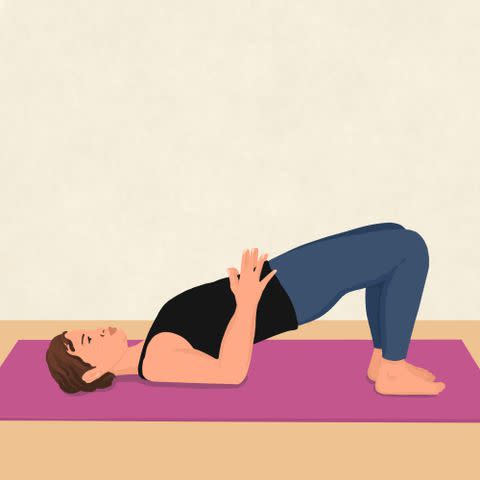
Grace Canaan
Lie face up on the floor with knees bent and feet flat on the floor. Arms can either be placed down by your sides, on your lower belly, or, if possible, walk your shoulders in and interlace your hands to rest under your back. Exhaling to engage your pelvic floor and core muscles, press into your arms and shoulders, squeeze your glutes, and lift your hips off the floor until your hips are parallel with your knees. Repeat 10 to 20 times, holding each one several seconds. If this is uncomfortable, place a block between your thighs.
Pelvic floor benefits: Bridges strengthen the pelvic floor, lower back, glutes, core, and other surrounding muscles so they can provide stability to your pelvis.
Belly Breathing
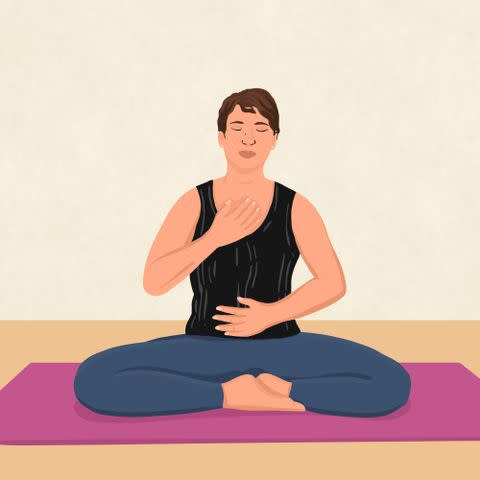
Grace Canaan
Sit down with your legs crossed or lie flat on your back with knees bent. As you inhale, feel your breath moving in a 360-degree motion (forward, side, and backward) without feeling your upper chest and neck expand. Feel your pelvic floor relax and elongate. On the exhale, let your body return to its normal state, drawing your pelvic floor up and diaphragm and rib cage down and in. Repeat 10 times.
Pelvic floor benefits: Deep breathing or belly breathing, relaxes and releases the pelvic floor, which is especially beneficial for those with a tight pelvic floor.
Related: You Might Be Ignoring the Most Important Ab Muscle You Have—Here's How to Strengthen It at Home
For more Real Simple news, make sure to sign up for our newsletter!
Read the original article on Real Simple.
